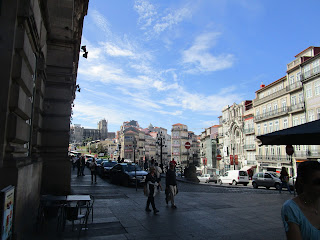 |
| At the Pelourinho. The town pillary. |
Ana, the tour guide, is the one in red.
We started at the São Bento train station.
Which we were informed was once a convent, seized by the anti-clerical government in the 1800's. They seized the convent, but promised not to evict any of the nuns. It took 70 years for the last nun to die.
The São Bento train station is the one with the blue "azulejo" tiles depicting scenes of Portuguese history. Across the street was a church decorated with the azulejos:
We were warned not to stand under this tree:
It's like something out of a Tippi Hedren movie.
This is the Teatro Nacional São João.
It was once an opera house. Then it was a movie theater. Now it's a live-theater kind of theater.
This was my first sighting of a tourist train type transport in Porto. Foreshadow: it would not be the last.
I'm on a walking tour, not a train-riding tour, so let's keep walking. To the bridge.
This time I'm on the upper deck of the Ponte Luis I, which, apparently. according to the walking tour guide, was NOT designed by Gustave Eiffel. Even though the street underneath it bears the name "Avenida Gustavo Eiffel." It was designed by Eiffel's one-time cohort, Theophile Sayrig. The Portuguese king ordered a design contest to build this bridge. Eiffel lost. Sayrig won. Yet everyone seems to associate this bridge with Eiffel. Hence the street name.
Let's look down to the right (west):
Let's look down to the left (east):
But this is my favorite view when crossing a high bridge:
Eyes locked straight ahead.
When we returned to solid earth, there was yet another tourist train:
Again, this is an organized walking tour, not a train-riding tour. So let's WALK to the Cathedral:
Cathedrals in Lusophonic countries are always called "Sé," which is short for something I don't remember. But they are always called "Sé." That I remember.
Impressive under-carriage to the anatomically-very-correct horse statue.
This is the side view of Porto's Sé Cathedral:
And this is the main entrance:
And this is the Pelourinho:
It is not the original. The original was destroyed when the Portuguese government opted to stop public executions. It was reconstructed by the Portuguese fascist dictatorship as a "historical reminder." Fortunately, it was not used for its historic purpose. That was done behind closed doors.
This is a monument to the 4000 people who died when a bridge made of boats was destroyed at the time of a French invasion.
Portugal is now experiencing a major tourist invasion. The bad news is long lines everywhere. The good news is improved infrastructure for us tourists.
Like these free (but tip) walking tours,




















No comments:
Post a Comment